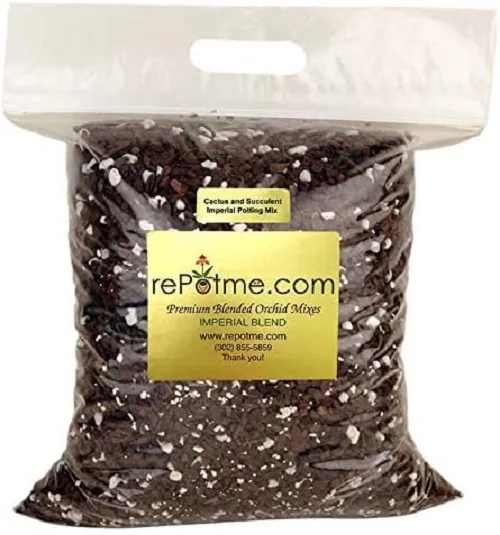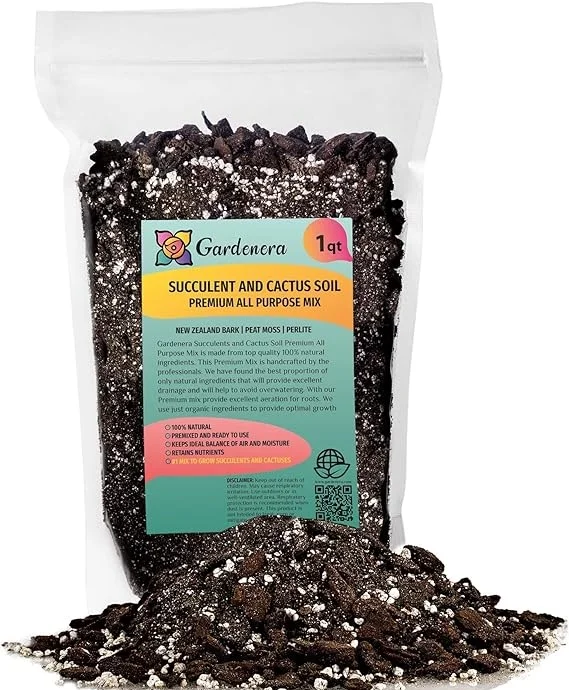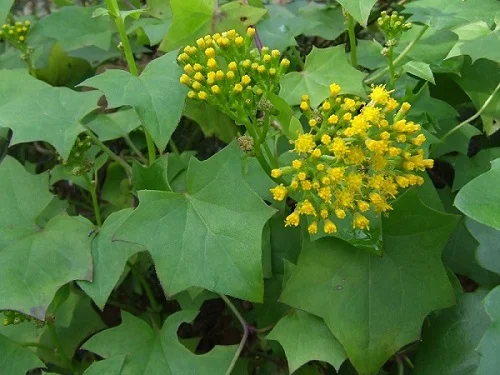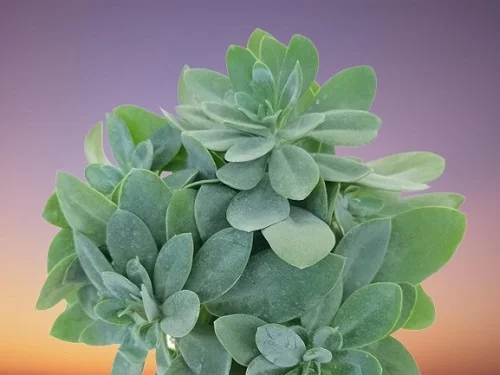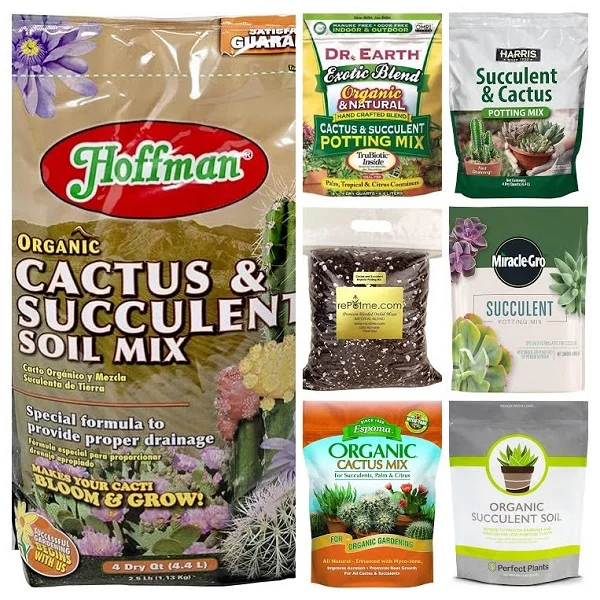String of Watermelons Plant (Senecio herreanus) Care Indoors, Propagation, Problems and Solutions
Some links in this post may be affiliate links
String of Watermelons Plant (Senecio herreanus) thrives in bright light with some direct sunlight, moderate warmth, average humidity and moderately moist, rich, well-drained, succulents soils coupled with monthly feeding in the growing season.
Senecio herreanus also called String of Raindrops Plant or Gooseberryplant is one of the popular Senecio varieties and bears pendant thread-like stems on which are succulent, oval-shaped, dark-green leaves with purple stripes which resemble the rind of the watermelon fruit and hence the common name.
Each leaf bears a translucent window that runs the length of the leaf which allows light to reach into the interior of the leaf where photosynthesis takes place.
The odd shaped leaves is an adaptation to arid conditions and allows for the storage of water while exposing minimum surface area to the dry desert air which greatly reduces water loss.
The leaves and fleshy stems store water, which allows the plant to go for a considerably long period without being watered. These characteristics make Gooseberryplant one of the popular drought-tolerant plants with low water needs.
On account of its drought tolerance and requirement for bright light with exposure to some direct sunshine, String of Raindrops Plant is one of best sun-loving plants for the home or office space.
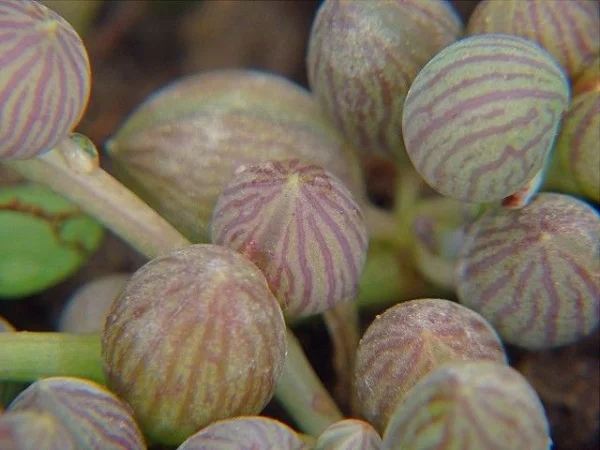
Botanical name: Senecio herreanus
Synonmy: Curio herreanus
Family: Asteraceae
Common names: String of Watermelons Plant, String of Raindrops Plant, Gooseberryplant
Origin
Senecio herreanus also called Curio herreanus is a creeping, perennial, succulent vine native to the drier parts of Southwest Africa.
In its natural habitat, the plant grows as a trailer, with stems trailing on the ground, rooting where they touch and forming dense mats. It is found growing in the shaded conditions growing under other plants and rocks. It is among the popular string of plants and one of the best hanging succulent plants for the home or office.
Is String of Watermelons toxic?
Yes. String of Watermelons like other Senecio species is toxic to humans and pets as outlined by ASPCA. If ingested, it can cause drooling, vomiting, diarrhea and lethargy. Contact with the plant sap may cause skin irritation or skin rash in sensitive skin therefore, always wear gloves when handling the plant. Keep it away from the reach of children, cats and dogs to avoid mishaps.
Where to Buy
String of Watermelons Plants are beautiful plants to add to your collection. You may obtain these plants online from Etsy (Link to Etsy).
How to care for String of Watermelons Plant indoors
To care for String of Watermelons Plant indoors, give it bright light with 4-6 hours of direct sunshine, moderate warmth of 20-270C, average humidity of 50-55% and moderately moist, fertile, well-drained, succulents soil coupled with monthly feeding during the growing season.
Senecio herreanus care requires pruning to keep the plant neat, to reduce pest and disease infestations and rejuvenate growth. Repotting is only needed when the plant has become pot-bound. Keep reading for more on these growing conditions and how to achieve them.
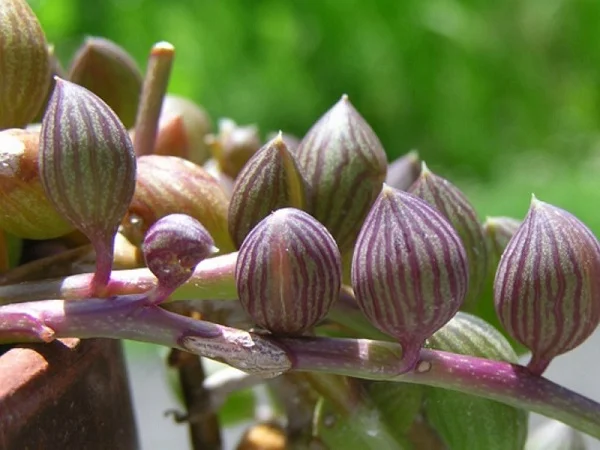
Light Requirements
How much light does a String of Watermelons Plant need?
String of Watermelons Plant needs bright light with at least 4-6 hours of morning or late afternoon sunlight. The bright light enhances the purple tones on the leaves.
Too little light will cause the Curio herreanus to become leggy and loss leaf color. Therefore, if the natural lighting is not adequate, use a full spectrum grow light to supplement it.
Rotate the pot regularly to ensure that the plant receives light on all sides for a balanced growth as well as prevent legginess.
Watering
How often should I water a String of Watermelons Plant?
Water your String of Watermelons Plant liberally in spring and summer while allowing the top 2-3 inches of soil to dry out between waterings. Keep the soil moderately moist and avoid overwatering which can result in rotting, yellowing and leaf drop.
Decrease watering in fall and winter to maintain the soil barely moist. However, do not allow the soil to dry out completely as it can lead to wilted (shrivelled) leaves and leaf drop.
Use water that is at room temperature to avoid cold shock which can cause reduced growth and leaf drop. Water with chlorine-free water like rain water to avoid getting brown leaf spots.
Ascertain that the pot has a drainage hole and the soil is well-draining to prevent waterlogging as it can lead to rotting and loss of the plant.
Temperature and Humidity
String of Watermelons Plant flourishes in an average warmth of 20-270C; a room temperature that is comfortable for you is ideal for this plant. Keep the plant away from drafts as they cause sudden temperature flactuactions which can lead to stunted growth and leaf drop.
String of Raindrops Plant has no need for high humidity; average room humidity of 50-55% is ideal for this plant. Ensure that there is good air circulation to discourage fungal disease infestations.
Fertilizer
Feed your String of Watermelons Plant with a balanced, liquid fertilizer monthly during the growing season (spring and summer). This plant is not a heavy feeder so be careful with feeding to avoid excessive feeding.
Stop feeding in fall and winter as growth is minimal at this time and feeding at this time can cause fertilizer burn and eventual death of the plant.
Potting Soil
What kind of soil does String of Watermelons Plant like?
String of Watermelons Plant likes a rich, loose and well-draining soil at a PH of 6.0-7.0. The soil should be loose enough to allow water to drain out fast enough to avoid waterlogging; cactus and succulents mixes are ideal for this plant as they drain easily.
Repotting
How to repot a String of Watermelons Plant?
String of Watermelons Plant has a small root system so frequent repotting is not necessary. Repot it at the beginning of the growing season only when it becomes crowded in its current pot.
- Select a shallow pot that is 1 size larger than the current one that has a drainage hole to prevent the soil from getting soggy to avoid rotting. Take a look at these succulents pots available on Amazon.
- Fill the pot halfway with a succulents soil and moisten the soil lightly.
- Carefully remove the plant from its current, loosen the soil around the roots and remove excess soil.
- Position the plant in the center of the pot, spread out the roots and continue filling the pot while firming the soil around the roots. Be careful not to bury the stems to prevent rotting
- Wet the soil thoroughly and replace the plant to its original spot.
Pruning
Pruning String of Watermelons Plant involves removal of any dead leaves or stems to keep the plant neat and also reduce pest and disease infestations.
Trim the stems at the beginning of the growing season if they become too long or straggly to rejuvenate growth. You may use the stems to propagate new plants
Propagation
How do you propagate String of Watermelons Plant?
String of Watermelons Plant is propagated from stem cuttings at the beginning of the growing season (spring to early summer) when in active growth.
Propagating String of Watermelons from stem cuttings
- Take 3-5 inches of stem cuttings from a healthy plant and ensure it has at least 2-3 leaf nodes.
- Allow the cuttings to dry (callus) for about 7 days to prevent rotting.
- Lay the stems on moist, well-draining succulents soil and lightly press the stems into the soil at the nodes.
- Place the set up in a warm, well-lit place away from direct sunlight to avoid scorching.
- Maintain the soil moist until the stems are well rooted.
- Once there is substancial growth, transplant the new plant into a pot one size larger after which you can begin routine care.
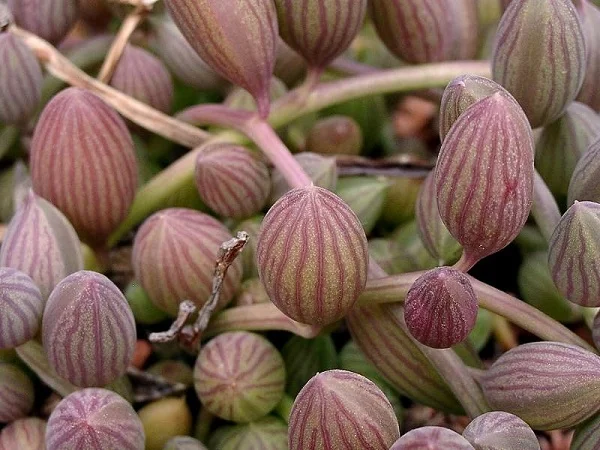
Senecio herreanus Problems & Remedies
String of Watermelons Plant (Senecio herreanus) problems are plant dying, stunted growth, yellow leaves, leaf drop, leggy growth, wilted and shrivelled leaves, leaf spots, pests and diseases among others. Keep reading for more on these problems and how to fix them.
Plant dying
Why is my String of Watermelons Plant dying?
Your String of Watermelons Plant is dying due to root-rot which is prevalent in soggy soil. The disease presents as yellowing and wilting of the leaves which is rapidly followed by browning and plant collapse.
How to fix it
- Gently, slip the plant out of its pot and inspect the roots; brown-black mushy roots indicate root-rot.
- Cut away the rotten roots and treat the healthy roots with a copper-based fungicidal solution as recommended by the manufacturer.
- Repot the plant in fresh soil and a fresh pot. Use a pot with a drainage hole and well-draining soil to prevent it from getting soggy.
- Place the plant in bright light and withhold watering for a few days to give the plant enough time to loss the excess water. After the dry period, resume routine care.
Stunted growth
Why is my String of Watermelons not growing?
Your String of Watermelons is not growing due to inconsistent watering, soggy soil, use of cold water, drafts or too little light.
How to fix it
Inconsistent watering: Do not water on a schedule. Water when the top 2-3 inches soil dry out but never allow the soilball to dry out completely.
Soggy soil: Use a pot that has a drainage hole and well-draining succulents soil.
Use of cold water: Water the plant with water that is at room temperature to avoid cold shock.
Drafts: Keep the plant away from drafts coming from AC units, hot air vents, hot stoves, windy doors, drafty windows among others.
Too little light: Position the plant in a brighter spot where it will receive bright light with at least 4-6 hours of direct sunshine or use a grow light is the natural light is not sufficient.
Yellow leaves
Yellow leaves on String of Watermelons Plant is caused by inconsistent watering, soggy soil or too little light.
How to fix it
Inconsistent watering: Water when the top 2-3 inches soil dry out but never allow the soilball to dry out completely. Do not water on a schedule.
Soggy soil: Use a pot that has a drainage hole and well-draining succulents soil.
Too little light: Place the plant in bright light with 4-6 hours of direct sunshine or use a grow light is the natural light is not adequate.
Leaf drop
Leaf drop on String of Watermelons Plant is caused by use of cold water, inconsistent watering, soggy soil or cold drafts.
How to fix it
Use of cold water: Water the plant with water that is at room temperature to avoid shocking it.
Inconsistent watering: Do not water on a schedule. Water when the top 2-3 inches soil dry out but never allow the soilball to dry out completely.
Soggy soil: Use a pot that has a drainage hole and well-draining succulents soil.
Cold drafts: Keep the plant away from cold drafts coming from AC units, windy doors, drafty windows and others.
Leggy growth
Leggy growth (elongated stems) on String of Watermelons plant in fall and winter is due to overwatering or soggy soil.
How to fix it
Overwatering: Cut down on watering in the cold season to keep the soil barely moist.
Soggy soil: Ensure that the pot has a drainage hole and the soil is well draining to prevent the soil from getting soggy.
If leggy growth on String of Watermelons Plant happens during the growing season (spring and summer), then the cause is too little light.
How to fix it
Move the plant to a brighter spot and ensure it receives bright light with at least 4-6 hours of direct sunshine or instal grow lights if the natural lighting is not enough.
Wilted, shrivelled leaves
Wilted, shrivelled leaves on String of Watermelons Plant is caused by underwatering, soggy soil, and drafts.
How to fix it
Underwatering: Immediately water the plant thoroughly and it should recover.
Thereafter, water when the top 2-3 inches of soil to dry out but do not allow the soil to dry out completely.
Soggy soil: Use a pot with a drainage hole and well-draining succulents soil.
Drafts: Keep the plant away from drafts emanating from AC units, stoves, windy doors, drafty windows and others.
Brown dry spots
Brown dry spots on String of Watermelons Plant are due to underwatering. Water the plant when the top 2-3 inches of soil dry out but do not allow the soil to dry out completely.
Pests
Common pests on String of Watermelons Plant are spider mites, mealybugs and scale insects.
How to fix it
- Isolate the affected plant to prevent spread to other plants.
- Treat the infested plant with neem oil or insecticidal soap as per the manufacturers' instructions.
- Check between the leaves for these pests and carry out timely control measures.
- Keep the plant well pruned to discourage the pest infestations.
Diseases
String of Watermelons Plant is prone to the following three diseases:
1. Powdery mildew which is characterized of spotting or coating of the leaf surface with a white powdery deposit.
How to fix it
- Remove the badly affected leaves and discard or burn to reduce spread to other parts of the plant.
- Spray the plant with a systemic fungicide. Ensure to follow the instructions on the label.
- Improve the air circulation for your plant to reduce the occurrence of the disease.
2. Leaf spot disease which presents as brown, soft leaf spots.
How to fix it
- Isolate the affected plant and treat it with systemic fungicide as per the manufacturer's recommendations.
- Avoid wetting the leaves during watering to minimize the disease infestation; water from the bottom instead.
- Maintain a good air flow for the plant to discourage the disease.
3. Basal stem-rot disease which is prevalent in overwet conditions. It is characterized by a rotting plant base and stems collapse.
How to fix it
- Use the upper healthy stems to propagate new plants and discard the infected parts to reduce spread to the rest of the plant.
- Thereafter, water the plant when the top 2-3 inches of the soil dry out.
- Ensure that the soil is well-draining and the pot has a drainage hole.
You liked it? Share on social media.
Related Content
Amazon Associates Disclosure
Homeplantsguide.com is a participant in the Amazon Services LLC Associates Program, an affiliate advertising program designed to provide a means for sites to earn advertising fees by advertising and linking to amazon.com.
